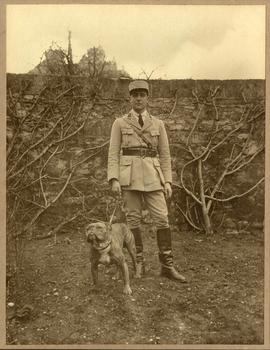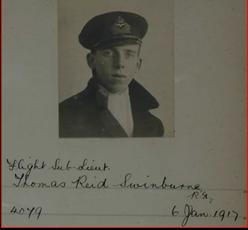Swann, Graham Templer, son of the Rev. Arthur Henry Swann, Vicar of Christ Church, Fulham, Middlesex, by Agnes Jane, daughter of the Rev. Thomas William Graham, Vicar of St. Matthew's, Southborough, Kent; b. June 29, 1902; adm. Sept. 21, 1916 (G); left July 1921; Emman. Coll. Camb., matric. Michaelmas 1921; B.A. 1924; asst. master R.N. Coll. Dartmouth Sept. 1924, and subsequently at Harrow; Pilot Officer (General Duties) R.A.F.V.R. July 19, 1938; transferred to A. and S.D.; Flying Officer Jan. 19, 1940; temp. Flight-Lieut.; killed on active service July 1941.
Graham Templer “Swanny” Swann was born at Southborough, Kent on the 29th of June 1902 the son of the Reverend Arthur Henry Swann, Vicar of Christ Church, Hampstead, and Agnes Jane (nee Graham) Swann of 45, High Street, Harrow-on-the-Hill in Middlesex. He was educated at Westminster School where he was up Grant’s from the 21st of September 1916 to July 1921. He was appointed as a Monitor in 1920. He was a member of the 1st Cricket XI in 1921 when the Elizabethan wrote the following on his season: - “Not a polished batsman: should have confined himself to hitting simply and solely. Could bowl at a pinch; chiefly distinguished himself by energetic and, at times, brilliant out fielding.” He was awarded his School Cricket Colours in 1921. He was a member of the 2nd Football XI in 1919 and of the 1st Football XI from 1919 to 1921 where he played at inside right. The Elizabethan wrote the following on his 1920/21 season: - “Looks a good player, but never seems to do the right thing, largely due to over anxiousness. Must be more calm and collected, and must use his intelligence more for spotting openings. Has a fine burst of speed, a most useful asset.” He was awarded School Colours for Football in 1921. He was a member of the Officer Training Corps and was promoted to Lance Corporal in September 1920.
He matriculated for Emmanuel College, Cambridge in 1921 and was awarded a BA in Modern and Medieval Languages in 1924. He was the first civilian member of Toc H. On leaving university he was appointed as an assistant modern languages master at the Royal Naval College, Dartmouth and later at Harrow School. While at Harrow he accompanied boys from the Air Training Section of the Officer Training Corps to a RAF Camp.
He was awarded a Royal Aero Club Certificate (No. 10655) at Haldon Aerodrome on the 23rd of July 1932 while flying a Gypsy Moth aircraft.
He was commissioned as a Pilot Officer on probation in the Royal Air Force Volunteer Reserve on the 19th of July 1938 and was moblisied on the outbreak of war. He was promoted to Flying Officer on the 19th of January 1940 and by June 1941 he was billeted at “Sand Green”, Crossfield Avenue, Porthcawl in Glamorganshire.
Graham Swann took off from RAF Stormy Down in Battle Mk I L5001, with his pilot, Pilot Officer Eric Geoffrey Kitching, for a co-operation exercise with a local Home Guard unit which was to take place at Margam Castle, Port Talbot. At the time, he had accumulated 840 hours of total solo flying time of which 698 were on Battle aircraft. As the aircraft was making a low level turn the pilot misjudged his height and the aircraft struck a 45 foot tree and crashed 200 yards further on in a field at Eglwysnunydd Farm on the Margam estate at 10.25am where it burst into flames on impact, killing both men. The wreckage was in three large pieces which were spread over an area of 60 yards. The bodies of the two men were taken to the mortuary at RAF Stormy Down.
His brother-in-law, the Reverend G.V. Hart, received the following telegram dated the 23rd of June 1941: -“Deeply regret to inform you that your brother in law Flight Lieutenant Graham Templar Swann is reported to have lost his life as the result of an aircraft accident on June 22nd 1941. The Air Council express their profound sympathy. His mother had been informed.”
His funeral took place on the 27th of June 1941.
The Harrow School magazine, the Harrovian wrote: - “Of the many hundreds of boys who have passed through Harrow while Swanny was on the staff, there must be very few who cannot claim to have been his friends. To be in his French or German Division was often but the prelude to such a friendship and a good prelude it was. His intimate resource in keeping the subjects alive was the envy of all his Modern Languages colleagues. In many spheres of activity outside the form room he played a prominent part. He was a tireless Rugger coach – self-taught – be it added. It is typical of his enterprise, for he came from a soccer school and played his first Rugger games as a Dartmouth master. If he was missed on the cricket field, it was because he was indispensible for the Sailng Club. He shared willingly his exceptionally wide and varied interests. One would find groups of boys in his study at all hours of the day, listening to Bach or Beethoven on his gramophone, enjoying his inexhaustible fund of photographs or his War Museum. This last, by the way, was but one of his many hobbies, and one had to see him at work to realise what hobbies could mean. He took greatest pride of all in the creation of the model railway club, which, even since he left Harrow to join up, has had perhaps the largest following of any school club. If the above record fails to picture him as more than an attractive Mr. Chips, a glance at his other activities will soon dispel the illusion. A great traveller, he visited during his holidays every corner of the earth. Titles of lectures to the school and on the wireless, “£17 to India”, “With £10 across America” etc., bear witness to his venturesome spirit, which was indeed one of his most attractive facets. “The harder of two alternatives” was his guiding principle, and he had the courage to carry it through. With his colleagues he was universally popular. It was not everyone who agreed with his opinions, for his conclusions, inflexible as they were, he formed after long and deliberate thinking. But no one could fail to enjoy his quick wit and genial humour, and he was the kindest of friends. It was the spirit of adventure that led him to take up flying. After much useful work with the Air Training Section of the School O.T.C., he joined the R.A.F.V.R. shortly before the outbreak of war, and was called up when hostilities began. But he spent much of his leave at Harrow and kept many of his friendships alive; and those boys who were privileged to be his guests during A.T.C. camps at the R.A.F. station to which he was attached, will long treasure the memory of that fearless pilot who worked unstintingly on their behalf, sparing no pains to make their visit a happy one. Seldom has the war been brought more vividly to Harrow as a whole than by the news of Swanny’s death.”
The Elizabethan wrote: - “His deep sympathy and insight into the character of his pupils, his sense of humour and the high standards he set himself and others evoked the respect and affection of all among whom he worked. He was fond of adventure and a great traveller, and is said to have completed a tour of 11,000 miles in one summer holiday.”
He is commemorated on the war memorial at Emmanuel College, Cambridge and on the memorial to Harrow School Masters at Harrow School.
He is buried at Putney Vale Cemetery and Crematorium Block D.4, Grave 343.


